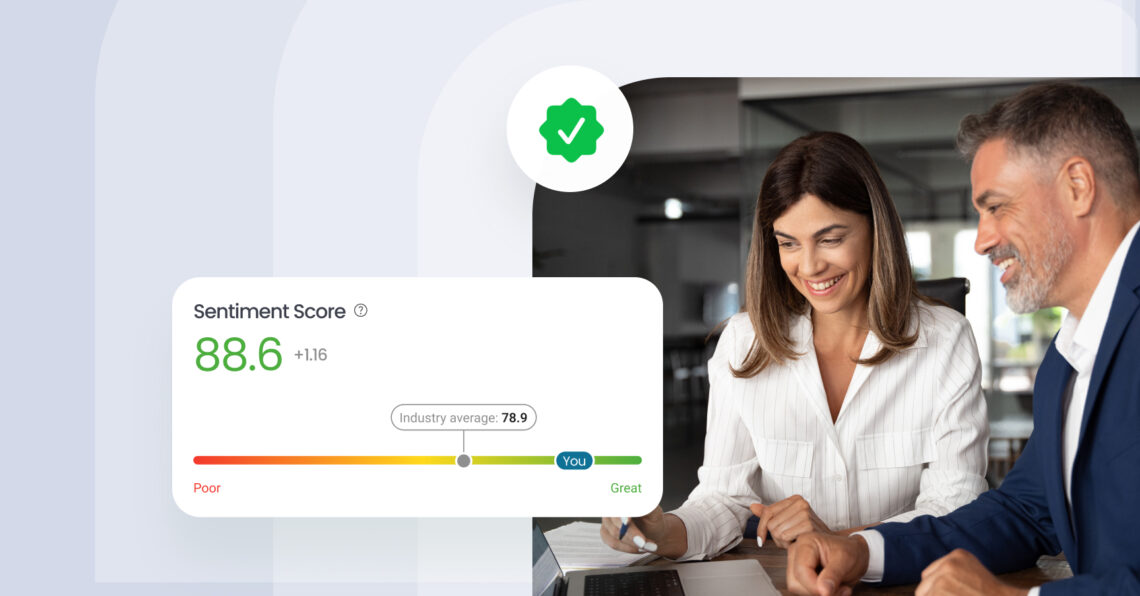Sentiment score isn’t just a metric—it’s your best shot at catching what star ratings and survey boxes often miss. Every day, customers share their thoughts across review sites, chats, and social media—but without understanding the emotion behind their words, brands risk acting on surface-level signals.
Why does a 5-star review still sound irritated? Why do some 3-star reviews read like love letters? The disconnect lies in tone, and sentiment scoring helps decode it.
Businesses are now realizing that reading between the lines is no longer optional if you want to respond in time, retain unhappy customers, or fix what’s broken before it trends.
Read this blog further to learn what a sentiment score is, how it’s calculated, and how brands are turning emotional signals into business growth, with real examples from storage, dental, education, and consulting industries.
💡Here’s the twist most brands miss
A high sentiment score doesn’t always mean customers are happy—it often just means they’re polite. Emotion lives in the nuance, and brands that pay attention to tone, context, and intent outperform those that chase averages.
It’s not about volume—it’s about emotional clarity.Table of contents
- What is a sentiment score, and how does it work?
- Why sentiment scoring is essential to customer experience and retention
- Where sentiment scores make the biggest business impact
- What sentiment scoring gets wrong (and how GenAI makes it better)
- How Birdeye GenAI helps businesses unlock deeper sentiment insights
- FAQs about sentiment score
- Birdeye helps you understand customers’ true emotions with a sentiment score
What is a sentiment score, and how does it work?
A sentiment score is a numeric value assigned to a piece of text, such as a review, survey response, or support message, that reflects the emotion expressed in it. Typically ranging from -1 (strongly negative) to +1 (strongly positive), this score is the result of analyzing sentiment in the language your customers use every day.
What makes it valuable isn’t just the number—it’s the why behind it. Unlike a star rating, a sentiment score helps surface the positive and negative emotional cues hidden in customer feedback.
For multi-location businesses, this becomes critical, especially when feedback flows in from social media platforms, chats, forms, and survey responses.
That’s where GenAI solutions like Birdeye’s Sentiment Score stand out. Instead of simply assigning a value, Birdeye distills textual data into structured insights by:
- Assigning location-based sentiment to show how different branches are performing
- Breaking down category-based insights to highlight which parts of your service drive positive or negative sentiment
- Generating smart insights and summaries using GenAI to help you act on issues faster
- Creating themes and snippets from reviews, revealing patterns your team might otherwise miss
Let’s break down how this score is actually generated—and why your system needs more than basic text analysis to get it right.
Why sentiment scoring is essential to customer experience and retention
Every business collects customer feedback, but not all feedback is equal. A long, glowing review can still hide frustration. A short comment can signal deeper loyalty than a 5-star rating.
That’s why sentiment scoring has become critical for understanding customer sentiment across touchpoints.
How National Storage Affiliates extracted key sentiments using Birdeye
Take National Storage Affiliates, for example. With hundreds of locations, they struggled to identify where service issues were rooted without manually sifting through reviews.
They adopted Birdeye’s Sentiment Score to automate this analysis. Using location-based sentiment tracking, they began identifying which sites were underperforming emotionally, not just operationally.
The team then used Smart Insights to analyze category-level trends, such as “staff professionalism” or “unit cleanliness,” and made targeted improvements.
As a result, customer satisfaction scores rose, and negative themes across locations began to decline within 90 days.
South Georgia Dental garnered key themes with Birdeye
Similarly, South Georgia Dental realized its online reviews told a mixed story. While their star ratings looked strong, negative sentiment kept surfacing around front-office communication. That disconnect prompted them to use Birdeye Insights AI to break down themes and snippets within reviews and understand the true Net Promoter Score.
The system flagged specific issues (like “long wait times” or “unclear billing”) using AI-generated summaries, and leadership quickly rolled out new front-desk protocols. They didn’t just address complaints—they stopped them before they became trends.
Sentiment scoring helps you:
- Identify trends in negative feedback (even when masked by polite language)
- Surface brand perception risks before they impact reputation
- Respond proactively to emerging trends from reviews, surveys, and social media posts
- Adjust messaging and service delivery in real time based on final sentiment scores
When your brand is tuned into positive, negative, and neutral sentiment, you don’t just respond—you anticipate.
Now that you understand the why, let’s explore how different teams—from service to strategy—use sentiment scores to drive real business impact.
Sentiment Score Helps Your Business Hear What Customers Aren’t Saying Out Loud
Want to see the impact of Birdeye on your business? Watch the Free Demo Now.
Where sentiment scores make the biggest business impact
From customer service to competitive benchmarking, businesses are using sentiment data to improve everything from communication scripts to marketing campaigns.
Here’s where it matters most:
Customer experience teams: Prioritize emotional signals, not just star ratings
Support teams rely on sentiment analysis tools to catch issues before they spiral. An online review may contain positive feedback, but buried within it could be phrases that flag future churn.
With opinion mining and category-based tagging, CX teams can catch when someone says, “The dentist was great, but the wait time was unacceptable.”
Tools like Birdeye’s Smart Insights don’t just extract tone—they generate summaries, highlight recurring positive, negative, or neutral themes, and even suggest next actions. This helps teams move from reaction to prevention.
Operations teams: Spot inconsistencies across locations
If you’re managing 10 or 300 locations, you know how hard it is to spot patterns. By calculating sentiment scores by location, Birdeye helps ops teams benchmark average scores, pinpoint which branches are falling behind, and determine whether it’s tied to staff, service, or other unstructured data.
This is where document-based sentiment analysis shines—it allows insights from forms, internal surveys, and text data to be centralized, compared, and acted on.
Marketing teams: Align messaging with emotional cues
Using sentiment analysis technologies, marketers can understand how their campaigns are resonating emotionally, not just by CTRs or conversions, but by how people describe the experience. When paired with social listening tools, you can understand the emotional tone in social media comments and reviews.
Instead of just counting positive sentiment mentions, brands now extract meaningful insights like:
- “Pricing feels predatory”
- “Staff is warm and makes patients feel safe”
- “Hard to get through on the phone”
These are emotion-first metrics—not just KPIs—and they’re only visible through sentiment analysis systems that track brand sentiment across platforms.
Strategy and research teams: Guide decisions with emotional data
Whether you’re conducting market research, testing new messaging, or evaluating product feedback, the right customer behavior analysis model gives you an accurate picture of how your brand is perceived.
Unlike keyword or tag-based analysis, today’s models use machine learning algorithms, deep learning, and even stop words context to reflect human language better.
Paired with tools like Birdeye’s AI recommendations, leaders can skip the dashboards and go straight to decisions, without waiting on analysts or data scientists.
Of course, scoring is only useful if it’s accurate and reliable. So what are the limitations of traditional sentiment systems—and how does GenAI close the gap?
What sentiment scoring gets wrong (and how GenAI makes it better)
For all its potential, traditional sentiment analysis still has blind spots. Most legacy systems struggle with unstructured data, sarcasm, mixed emotions, or context that shifts the meaning of certain words. That’s because many of them rely on outdated sentiment analysis models that assign a score based solely on word presence, not on intent.
Take this example:
“The staff was fine, but I wouldn’t recommend this place to anyone.”
Old-school tools might detect positive words like “fine” and miss the overall negative sentiment. That leads to an inflated average score and missed warnings.
That’s where GenAI tools like Birdeye’s Insights AI come in.
Where GenAI improves sentiment scoring:
- Uses machine learning algorithms trained on real human language, not just lexicons
- Recognizes sarcasm, mixed tones, and industry-specific nuance
- Tracks themes and snippets over time, surfacing recurring issues across locations or categories
- Combines feedback from reviews, surveys, social media, and news articles into a single view
- Offers AI-generated summaries and AI recommendations so teams can act faster, without waiting for a full report
What sets Birdeye apart is how it combines traditional metrics like star ratings, review count, and sentiment score with contextual big data from every touchpoint. This delivers a clearer final score that reflects reality, not just algorithms.
In short, GenAI makes sentiment analysis important again by fixing what older systems miss.
Let’s look at how Birdeye’s full GenAI suite—especially Sentiment Score and Insights AI—helps businesses unlock location-based insights, category sentiment, and next-action guidance.
How Birdeye GenAI helps businesses unlock deeper sentiment insights
If your business wants more than just sentiment scores—you need actionable intelligence. Birdeye’s GenAI suite turns raw customer feedback into insight-driven strategies across every level of your organization.
Let’s break down how each product contributes:
Reviews AI: Turn emotion into action
Every review is a data point, but few businesses have the time to manually analyze them all. Birdeye Reviews AI automatically tracks, summarizes, and scores customer sentiment across 200+ review sites. It identifies positive and negative phrases, flags negative sentiment, and even writes AI-assisted replies in the customer’s language.
You also get:
- Review insights: Understand emotional patterns and CX issues at scale
- Competitive benchmarking: See how your sentiment compares across regions
- AI summaries: Get the big picture from thousands of reviews in seconds
- Review marketing: Turn high-sentiment reviews into ready-to-post content
Survey AI: Know what people feel, not just what they click
Unlike standard feedback tools, Birdeye Survey AI uses AI-driven analysis to score tone in real-time. Whether it’s a pulse survey or a full NPS questionnaire, it detects the emotions expressed and creates summaries for every question.
What makes it stand out:
- Reveal insights with survey reporting
- AI summaries of open-ended answers
- Review and referral prompts at the end of surveys
- Smart ticketing to escalate bad feedback instantly
Survey AI doesn’t just ask questions—it explains how your customers feel about your answers.
Insights AI: Spot patterns. Prioritize what matters.
Birdeye Insights AI acts as your team’s built-in analyst, surfacing hidden issues before they become reviews. It automatically pulls from reviews, survey responses, and social media comments, then organizes them into:
- Themes & snippets (e.g., billing issue, rude staff, long hold times)
- Reputation Score by location and category-based sentiment
- Smart AI recommendations for what to fix, where, and why
From small annoyances to systemic issues, Insights AI connects emotion to operations.
Competitors AI: Compare sentiment where it counts
Sentiment doesn’t live in a vacuum. With Birdeye Competitors AI, you can see how your sentiment score compares to others in your industry and region. It identifies competitive weaknesses, benchmarks tone trends, and even pulls themes and snippets from rival reviews.
Key uses:
- Benchmark brand sentiment and reputation
- Analyze online reputation monitoring signals
- Discover where your final sentiment score needs improvement
The result? You don’t just understand how your customers feel—you understand how they feel relative to your competitors.
Now that we’ve covered the tools powering sentiment insight, let’s bring it all together and recap why understanding emotion is your brand’s next competitive advantage.
What sentiment scoring means for your business in 2025
Sentiment scoring isn’t just about numbers—it’s about interpreting human behavior at scale. As multi-location businesses face rising customer expectations across reviews, chats, and survey responses, the ability to measure emotional tone quickly has become a non-negotiable advantage.
Traditional sentiment analysis tools may pick up on positive words or spot a few negative word counts, but they rarely capture context, sarcasm, or category-level nuance. That’s why sentiment analysis APIs alone aren’t enough.
You’re no longer just collecting data—you’re calculating sentiment scores that lead to better decisions, faster action, and real ROI.
So, whether you’re a dental chain trying to spot booking friction or a school navigating neutral sentiment in parent feedback, the goal stays the same: track emotion, improve outcomes, and act smarter.
FAQs about sentiment score
A sentiment score tells you whether a customer’s feedback is positive, negative, or neutral, based on the emotional tone of their words. It helps you understand how people feel, not just what they say.
Birdeye uses artificial intelligence and natural language processing to analyze reviews, survey responses, and social posts. It calculates a score by identifying positive words, negative words, and emotional cues across categories.
It helps track emotional trends across regions, identify service gaps, and resolve issues proactively. With Birdeye’s Insights AI, teams can act fast with AI-generated summaries and location-based sentiment breakdowns.
Yes. Star ratings only capture surface-level opinion, while sentiment scores reveal emotional depth. A 5-star review can still carry negative sentiment, which sentiment scoring helps detect and fix.
Birdeye helps you understand customers’ true emotions with a sentiment score
A sentiment score is more than a number—it’s a window into your customer’s emotional experience. But getting that clarity across locations, channels, and feedback types takes more than basic tools. It takes purpose-built GenAI.
That’s where Birdeye makes the difference with:
- Reviews AI summarizes tone across 200+ platforms
- Survey AI uncovers the emotion behind every answer
- Insights AI that surfaces trends before they escalate, Birdeye helps businesses turn emotion into action
- Competitor AI to track customer sentiment not just internally, but against your closest rivals
In a world of endless reviews and rising expectations, Birdeye doesn’t just tell you how your customers feel. It helps you do something about it.
Ready to unlock powerful emotional insights and improve customer experience across every location?

Originally published









